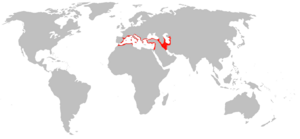Long-fingered bat facts for kids
Quick facts for kids Long-fingered bat |
|
|---|---|
 |
|
| Conservation status | |
| Scientific classification | |
| Genus: |
Myotis
|
| Species: |
capaccinii
|
 |
|
| Distribution of long-fingered bat | |
The long-fingered bat (Myotis capaccinii) is a special type of bat that eats meat. It's a kind of vesper bat, which is a common family of bats. You can find these bats living near the Mediterranean Sea and in some parts of western Iran. Sadly, their numbers are going down. Because of this, they have been listed as a Vulnerable animal since 1988 by the IUCN Red List. This means they need our help to survive.
Contents
What Does the Long-Fingered Bat Look Like?
The long-fingered bat is a medium-sized bat. It gets its name from its noticeably large feet. It also has nostrils that stick out more than other European Myotis bats.
These bats are about 47–53 mm (1.9–2.1 in) long. That's about the length of a small paperclip! They weigh between 7–13 g (0.25–0.46 oz), which is like weighing a few grapes. Their back feet are 10–13 mm (0.39–0.51 in) long and have long, stiff hairs. Their fur is dark grey near the skin. On their back, it's light smoky grey, and on their belly, it's light grey.
Where Do Long-Fingered Bats Live?
The long-fingered bat lives in many coastal areas. You can find them in North Africa, including Morocco, Algeria, and Tunisia. They also live in parts of Spain, France, Bulgaria, Italy, and the Balkan peninsula. Some even live on islands like Mallorca and Menorca in the Mediterranean Sea.
In Asia, they are found from Turkey to Israel, Iran, Iraq, and Uzbekistan. These bats prefer to live in wetlands and caves. They can be found in places up to 900 m (3,000 ft) high.
Sadly, the number of long-fingered bats is decreasing. In Spain, their population dropped by 30-50% since 2006. In France, there are fewer than 3,800 bats known. Bulgaria has more, with about 20,000 bats.
How Do Long-Fingered Bats Behave?
Long-fingered bats like to live in areas with limestone rocks. They prefer wooded or bushy places close to flowing water. During summer and winter, they always rest in caves. Sometimes, groups of up to 500 bats can be found together in these caves.
These bats love water. They are carnivores that hunt over water bodies. They eat small fish, water insects, and other tiny creatures. This includes things like ostracods (tiny crustaceans) and water fleas.
They need underground shelters, like caves, to rest during the day. When they hunt, they fly over water. They prefer rivers wider than 10 m (33 ft). These rivers often have lots of plants along the banks. These plants help keep the water calm and still. Calm water helps the bats use their echolocation more effectively to find food.
Bats use echolocation by sending out sounds and listening for the echoes. This helps them create a sound map of their surroundings. They also hunt for food while flying to their favorite hunting spots. This way, they get more done on one trip! Their summer resting spots are usually about 50 km (31 mi) away from their winter spots. Some travel as far as 140 km (87 mi).
Reproduction and Life Cycle
We don't know a lot about how these bats reproduce. Mating can start in August and continue until late winter or early spring. Pregnancy lasts for six to eight weeks.
Female bats form special groups called maternity roosts in caves during the summer. Up to 500 females can gather together on the cave roof. Very few males are present in these groups. Usually, only one baby bat, called a pup, is born in mid to late June. The pup is ready to live on its own after about four to six weeks.
What Threats Do Long-Fingered Bats Face?
Bats face three main dangers:
- Their resting places (roosts) disappear or are disturbed.
- Their hunting areas are changed or destroyed.
- Pesticides (chemicals used to kill pests) harm them.
The long-fingered bat is especially affected by the first two threats. Tourism can disturb their cave roosts, which is a big reason their numbers are going down. When their breeding caves are disturbed, it can lead to local groups of bats disappearing.
In Western Europe, changes to their habitat and roosts are a problem. In France, changes to rivers are harming them. Also, the main insects these bats eat, called chironomids, can collect harmful chemicals. When bats eat these insects, the chemicals can make them sick or even kill them. In North Africa, some long-fingered bats have been harmed for traditional uses.
How Are We Protecting Long-Fingered Bats?
The long-fingered bat is protected by laws in most countries where it lives. There are also international agreements, like the Bonn Convention and Bern Convention, that help protect them. These bats are listed in Annex II and IV of the EU Habitats and Species Directive. This means special steps need to be taken to help them.
In Spain, fences have been put up to protect some known bat colonies. To keep this species from becoming endangered, we need to protect their colonies and improve water quality. Experts suggest avoiding draining underground water sources and changing water bodies near their roosts. Since these bats rely on clear water and plenty of prey, protecting large waterways near their roosts is very important.


